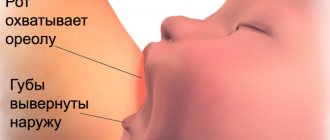Ways to increase lactation.
Many mothers worry if their milk production fluctuates and may decrease. You can stimulate lactation using the following methods.
- Start lactation as early as possible, preferably in the first hour after birth.
- Use a breast pump. The more milk you express, the more milk your glands will produce. A double breast pump will save time.
- Breastfeed more often. So, in the first months of life, a baby needs from 8 to 12 feedings per day. If you do not skip feedings, and even use a breast pump, then you should produce enough milk.
- Monitor your baby's proper latching and swallowing. It is effective sucking that stimulates subsequent lactation.
- Alternate breasts when feeding, since a full lactation should involve both with equal load. Be sure to express any accumulated milk. Any stagnation of milk leads to a slowdown in its production in the corresponding breast.
- Avoid taking certain medications. So, among the side effects there may be a decrease in lactation. Your doctor can advise you on analogues of medications that do not have similar negative properties.
Is additional breast hygiene necessary before breastfeeding?
Some mothers worry that the breast contains germs and bacteria that should not enter the baby's body, so they wash the area before each feeding. However, nature is not stupid and has provided for everything: the bacteria on the surface of the nipples are beneficial and stimulate the development of the baby’s intestinal microflora.
We recommend that women perform regular hygiene procedures as usual. When taking a bath or shower, wash your breasts and nipples with plain water, not shower gel or soap. Thus, the Montgomery glands on the areola produce fat, which gives the nipples natural moisture and protection from cracking. By degreasing them with care products, you can provoke discomfort during lactation. In addition, a child may be allergic to cosmetics.
How to properly put a baby to the breast during breastfeeding.
First of all, you need to take one of the correct natural poses, which we will look at below.
Next, make sure to observe the following points:
- the baby’s mouth is open wide, clasping the nipple, while the lower lip should be turned outward;
- The child’s tongue may appear above the lower lip, but periodically;
- the baby's chin is pressed tightly to the chest;
- cheeks remain rounded;
- during sucking, the child alternates short, quick movements with constant and deeper ones, and also makes natural pauses, which lengthen as hunger is satisfied;
- When sucking, the baby's ears may move;
- absence of slurping and smacking.
How to apply it correctly and set up the process
The baby's first feeding should occur, if possible, immediately after birth. And a woman should know what and how to do at this crucial moment.
First application
During the first and all subsequent breastfeedings, it is important to choose the correct position. The baby's head should be at the same level as his body.
The baby should be held horizontally.
If everything is done correctly, the baby will latch onto the nipple completely, and this is very important. Firstly, the risk of injury to the mother’s breast is reduced, and secondly, the baby will be able to fully eat
It is important to ensure that the baby grasps the areola of the breast to a greater extent with his lower lip, and a little less with his lower lip. In this case, the tongue should be under the nipple, since this way the baby will be able to breathe freely during feeding
How to tell if your baby is hungry
A hungry baby begins to cry uncontrollably, but the mother can prevent this. To do this, she needs to learn to determine that the child is hungry. They say it's time to feed:
- baby's concern;
- bending the arms and clenching the fists;
- licking fingers or constantly putting them to the mouth;
- movement of the lips, as when sucking a breast.
Tip! You can also place your finger or pacifier on the baby’s cheek near the lip. If he wants to eat, he will turn his head and begin to look for his mother's breasts with his lips.
Feeding schedule and duration
Each child sets his or her own diet. Don’t worry if your baby demands breastfeeding every hour or even more often. This is absolutely normal, and the only task of the mother is to feed the newborn when he wants it.
The duration of feeding may not be the same for each baby. Some babies suckle for 15 minutes, others can do this for 40 - 60 minutes. When the baby is full, he either falls asleep, or his arms and legs noticeably relax.
Previously, feeding a newborn was mandatory. It was recommended to put the baby to the breast every 3 to 4 hours. But today doctors are not so categorical, so you can feed the baby when he begins to show anxiety and look for the breast.
Comfortable positions and is it possible to feed while lying down?
The main positions for GW are as follows:
- Lying on your side. At this time, the baby lies facing his mother, his head is located on the elbow of his mother’s arm, and the woman supports the baby’s head with her palm.
- Lying on your back. In general, it is not recommended to feed the baby in this position, but if a woman had a caesarean section or had a difficult birth, she can take this position. In this case, the baby will lie on the mother's stomach, who supports him with her hand so that he does not fall.
- Sitting position. You need to sit comfortably in a chair or chair, bend your arm and place the baby’s head on the crook of your elbow. The palm should support the baby's butt, and his tummy should be pressed against his mother's belly.
If the position for feeding the baby has been chosen correctly, there should be no discomfort. But if the baby is anxious while suckling, you need to try changing the position.
Is there enough milk?
To understand whether a baby has enough milk, you need to pay attention to the following indicators:
- Urination and defecation. Normally, the baby pees at least 5-6 times a day, and bowel movements occur 2-5 times.
- Weight. If the baby has enough mother’s milk, he will gain a little more than 100 g per week. Thus, in a month the weight gain will be noticeable - 500 g.
According to the subjective sensations of the mother, the breast after feeding becomes soft and light, and the child behaves calmly.
Safety and hygiene
During breastfeeding, a woman must follow the rules of hygiene. Breasts can and should be washed before and after feeding, but it is recommended to use only warm, clean water for this. If milk leaks, you can use special pads. They are placed in the bra between the mammary gland and the cup of the bra. As soon as the gasket gets wet, it must be changed immediately.
Please note: It is important to take precautions during night feedings. In order not to crush the baby in his sleep, it is necessary to immediately transfer him to the crib after satiation and falling asleep. But if the baby is used to sleeping with his mother, then there is no need to worry that you can crush him in his sleep. Mother's sleep is very sensitive, so the brain reacts to any child's movements by awakening
Mother's sleep is very sensitive, so the brain reacts to any child's movements by awakening
But if the baby is used to sleeping with his mother, then there is no need to worry that you can crush him in his sleep. Mother's sleep is very sensitive, so the brain reacts to any child's movements by awakening.
Breastfeeding positions
These postures are mostly common for lactation.
- Cradle. It is considered the most popular and, at the same time, convenient. The mother sits comfortably, relaxes her back and takes the baby in her arms. Its head must be placed in the crook of your elbow, your tummy should be turned towards your body and the breast should be given on your own, making sure that the girth of the nipple is the same as described in the previous paragraph. With her other hand, the mother carefully supports the baby's back and bottom. It is important to ensure that the head is at the same height as the chest. You may have to raise your elbow higher at first, however, this is quite uncomfortable and tiring, so we recommend placing a pillow under your arm. Note that during feeding, the baby's head should be slightly tilted back, which promotes more efficient lactation.
- Reverse cradle. It is a variation of the “cradle” position, which is especially effective in the first days after discharge from the hospital. The pose should be practiced with babies who have not gained weight, as well as premature babies. So, the mother sits down comfortably, placing the baby on the palm of her hand (not the elbow). This ensures reliable support for the baby's head, as well as the ability to control it. Please note that for support you need a hand placed opposite the breast with which the mother is feeding. The palm must be placed under the shoulders and back of the baby, and the head, in turn, is between the fingers. With her second hand, the mother supports her breast from below, which she gives to the baby. The supporting arm may get tired in this position, so it is important to place support under it, such as a pillow.
- Lying on your side. At first glance, this position may seem strange to many, but it is most convenient during night feedings if the baby sleeps with the mother. It is also convenient to feed on the side if the mother had a cesarean section or episiotomy, and it is physically painful for her to sit. So, mother and baby both lie on their sides facing each other. The mother supports the breast with one hand and guides it into the baby’s mouth, and with the other she can stroke him soothingly.
- Relaxed pose. In this position, both mother and baby can completely relax and unwind. So, the mother basically takes a reclining position, raising her shoulders slightly. There should be a pile of pillows behind you to provide support for your back and shoulders. The baby lies on the mother’s body, and she supports him with her hands and helps him instinctively find the breast and begin feeding. The more the mother relaxes in this position, the more the baby calms down. The position is especially effective for capricious, active babies who actively swing their limbs during lactation and turn their heads.
A mother can independently develop comfortable feeding positions if both she and the baby experience complete comfort, and at the same time the quality of lactation remains at the same level. Also, the variability of poses can be supplemented with auxiliary devices: slings, pillows, etc.
How to put your baby to the breast: step-by-step recommendations
Moms who are wondering how to properly latch on to their baby for feeding should strictly follow the description below to achieve the desired results.
To make sure that everything is happening correctly, you can watch a photo of the feeding process or a video on how to properly attach your baby when feeding. https://youtube.com/watch?v=uktSC5yyw9U
We will discuss below how to properly breastfeed a baby.
Take a comfortable position
It is important that the shoulder girdle is relaxed. You should not start feeding while in an awkward position, as if the shoulder girdle is tense, milk production will be worse.
In the same way, milk is not released well if a woman is in a hurry, fussing, or very nervous during feeding. Sometimes it is difficult for a mother who has just given birth to a baby to sit. In such a situation, it is best to feed the newborn lying down.
Position the baby correctly at the breast
Proper attachment during breastfeeding is the key to successful natural feeding. To do this, you need to turn the baby's body towards the mother. When feeding while lying on her side, a woman should take a position so that she is in the same plane as her head. In this case, the baby's mouth should be at the same level as the nipple. In a different position, the baby will constantly pull on the breast, as a result of which the nipple will become injured. No need to restrain or clamp the newborn's head
It is important that the baby can twirl it easily
Ideally, you need to feed the baby in the “belly to belly” position - mother and baby should lie on their sides, facing each other. At the same time, the mother supports the child by the back or buttocks.
There is no need to be afraid that it will be difficult for the baby to breathe when he rests his nose on the mammary gland. There is no need to press on the chest near the nose to make it easier for the baby to breathe. Such actions will only worsen the flow of milk, and it will become even more difficult for the baby to suck. When he eats, he breathes through the edges of his nasal passages and feels quite comfortable.
Attachment of the baby
Every newborn has a latch reflex; it is innate. However, at first, you can help the baby latch onto the breast by moving part of the areola, but not the nipple, along his upper lip.
There is no need to put the nipple in your mouth - the baby will reach for the breast on its own. You can only help him by pointing his head in the right direction. The baby's mouth should be wide open when latching onto the breast. In this case, the lower lip should occupy the position that it will be during sucking - on the lower part of the areola, away from the nipple.
If everything is correct, then in the mouth there will be a nipple and part of the areola, the lower part of which will be captured more than the upper.
breast sucking
During the sucking process, the mother will be able to see part of the baby's tongue covering the lower gum. When the baby moves his tongue and lower jaw in waves, milk is squeezed out of the breast. The nose and chin should be pressed to the chest, the lips should be slightly turned outward. The baby's cheeks move in rhythm with the sucking movements. When the baby suckles, he makes deep swallowing movements.
By the way, if possible, you should feed your child naked, while undressing to the waist. Skin-to-skin touching will foster a powerful bond between baby and mom. And feeding will be very pleasant.
Factors that indicate the need to stop breastfeeding?
Basically, the mother herself will feel that breastfeeding can be stopped. After the baby has completely switched to complementary feeding (average age 6 months), he can be weaned painlessly. As a rule, starting at this age, the mother physically feels tired from breastfeeding; the process no longer brings those pleasant sensations that it did at the beginning. The baby uses the breast more as a toy or a means of attracting attention, calming, falling asleep, rather than a way of satiation. Moreover, teeth begin to erupt, which makes the lactation process not only tedious, but also painful.
Pediatricians advise that breastfeeding can be gradually reduced after six months and completely eliminated by 1-1.5 years. So, after one and a half years, it will be more difficult for a child to readjust psychologically, because for a long time the breast has been a symbol of maternal unconditional protection, reliability and love. Also, after a year, breast milk is not particularly beneficial for the baby and does not contain maternal antibodies that stimulate the baby’s immunity - the latter develops its own immune cells.
Many mothers continue to feed their baby until 3 or even more years of age, but this is their personal choice, often associated with certain psychological aspects. But being a prisoner of your own child with decayed teeth and lost hair is hardly the image you painted during pregnancy. In fact, neither the child nor you need such sacrifices.
Breastfeeding video. What does the video course consist of?
The course contains video lectures divided into thematic parts.
Lecture 1. “Breastfeeding - basic course” This lecture will talk in detail about what needs to be done, starting from the first minutes of your baby’s life, in order to establish breastfeeding. When is the best time to put a baby to the breast? The concept of correct grip. Why is it so important that in the first two days the baby eats colostrum and not formula? Should you wash your breasts before every feeding? Comfortable position for a woman during breastfeeding, pumping. Can I use pacifiers, bottles and pacifiers? Excessive milk supply. Late flow, lack of milk in the first days. Feed exclusively with breast milk until 6 months of age. Surroundings of a breastfeeding woman. Duration: 1 hour 6 minutes.
Lecture 2. “Breastfeeding problems, how to deal with them” This lecture will talk in great detail about the most common problems of breastfeeding. Careful study and following the advice will allow you to help yourself even in very difficult situations. Cracked nipples. Lack of milk, do you really have it, and what to do to overcome this problem? What steps to take if the baby is already sucking a bottle, but the mother wants to establish breastfeeding. Lactostasis, what is it? Step by step solution to the problem. Correct positions for feeding. Lymphatic drainage massage. Local treatment. Excess milk. Duration: 1 hour 49 min.
Lecture 3. “Introduction of complementary foods. When and how to wean your baby from the breast. Psychological aspects of breastfeeding” This lecture will be of interest not only to those women who are just preparing to breastfeed, but also to those who are already safely feeding their babies. When and how to start introducing complementary foods so as not to harm digestion and so that the child has a good appetite in the future? What is pedagogical complementary feeding? What foods to choose for complementary feeding? Until what age should a baby be breastfed? How to wean to minimize stress for the baby? How does breastfeeding affect a child's psychological health? Duration: 58 min.
What types of breast milk expression are there?
There are 2 main methods of expressing milk during breastfeeding: the manual method and the use of a breast pump. The latter can be electric or manual.
If periodic infrequent pumping is expected (for example, with lactostasis or hyperlactation after maternity hospital), then it is better to use the manual method. If pumping occurs quite regularly, then breast pumps will help save time and effort. Thus, electric double-sided devices make life much easier for mothers who express milk every day.
How to express breast milk correctly?
The most important rule during lactation is to carefully and carefully handle the mammary glands, since their tissues are very sensitive during this period.
Under no circumstances should you squeeze your breasts in your hands, strongly knead them, pull them, squeeze them, or try to “break” lumps and pockets of lumps on your own.
So, pumping itself consists of 2 procedures.
- Breast massage. It is necessary to prepare the mammary gland for lactation and stimulate the movement of milk forward. If it is necessary to express the right breast, then the same hand must be folded into a boat and the gland raised. The left palm is positioned so that the fingers hug the axillary lobe. The right hand smoothly moves up, and the left hand moves down, making clockwise movements. It is necessary to carry out about 4 such strokes.
- Just pumping. If the breastfeeding woman has large breasts, then they need to be slightly raised and always supported. Now place your index finger and thumb on the areola (about 3 cm from the nipple). Using your fingers, slightly pull the mammary gland towards you, close them, lightly squeezing the nipple. Make sure there is no pain. The latter can occur if the fingers are placed far from the nipple or the glandular tissue is additionally captured. After several characteristic movements, milk should drip or even actively flow from the nipple. Keep taking action. Change the position of your fingers a little to find the most comfortable one.
How to properly store and use expressed breast milk?
After you have expressed the milk, you must put it in the refrigerator for further storage. Freshly expressed milk stored at room temperature should only be given to the baby for a few hours.
During storage, milk may separate into the main milk mass and thick heavy cream. If, according to your assumptions, the child is able to eat the entire volume, then carefully mix the milk without active shaking movements. If the baby only needs to be fed, then it is better not to mix the layers, and then he will eat the most valuable heavy cream.
Freezing is only necessary if you do not intend to use the milk in the coming weeks, otherwise it will retain its freshness and beneficial properties on the refrigerator shelf.
Before freezing, cool the milk in a common chamber. Before putting it in the freezer, make a note with the date of pumping.
After defrosting, you must follow the same procedure. Move the milk from the freezer to the general compartment, and then place it under running warm water. Breast milk can only be heated to human body temperature, since enzymes decompose at higher temperatures, which impairs its natural properties. You can check the temperature without a thermometer on your wrist - the drops of milk should be moderately warm.
We do not recommend heating breast milk on the stove or in the microwave, since without a thermometer it is difficult to monitor and not overheat. Microwaves also kill many of the anti-infective agents in milk. It creates superhot zones that overheat certain layers of liquid.
After defrosting, breast milk may have a slight soapy odor and be slightly discolored. Some fatty acids behave this way. Most babies do not respond to these changes. But if after storage a pronounced sour or rotten smell appears, then the milk has spoiled and is not suitable for consumption.
Feeding lying down
The most comfortable position for breastfeeding is lying down. They help the woman to relax, you can even sleep next to the baby, because in the first days of life he suckles for quite a long time.
Find a suitable place for feeding: a sofa or bed. Sofas with a back are comfortable and safe: if necessary, you can leave it without the risk of the baby falling.
On the side
One of the popular positions used by women who have had a caesarean section. It eliminates pressure on the painful abdomen, which helps the mother endure the postoperative period more easily. The position becomes the main one for quiet night feedings when sleeping together. Neither you nor your baby will have to wake up for a snack at night.
Lie on your side, avoid resting on your elbow. Place a low pillow under your head. Position your baby side by side, just below the nipple
It is important that his head is thrown back, which will allow him to open his mouth well. Place the breast into the baby's mouth. Hold the baby with your hand under the shoulder blades. Place a towel cushion under your baby's back if you plan to take a nap.
This position may not be suitable for mothers of miniature babies, since lying on its side the baby cannot reach the nipple. In this case, use the following position.
On the hand
The baby's head appears slightly raised. This helps solve the problem of differences in the level of the nipple relative to the mouth. The mother does not need to reach out to the child, which often creates inconvenience: the elbow becomes numb, the back hurts.
- Lie on your side, make yourself comfortable.
- Place your baby on your side, with his head on your forearm.
- Hold his butt with the same hand. Give the breast freely.
To make you comfortable, provide support for your head. Use a pillow, but don't lie high on it; let your shoulders remain on the bed. This way you will prevent neck pain.
Baby pillow
Use a pillow instead of your own hand to support your baby. Your hands will remain free, and your baby will easily reach the nipple.
- Place a pillow on the bed and lie next to it on your side.
- Place your baby on his side on a pillow.
- Hold the baby by the shoulder blades and place the breast in his mouth.
Make sure that the pillow lies as close to you as possible. For proper feeding, it is necessary that the baby's tummy is pressed against yours.
Pillow for mom
In this position, a woman feeds with her upper breast. This helps in solving the problem of milk stagnation in the lateral lobe of the mammary gland, which is difficult to release in other positions.
- Place a pillow under your head, lie on your side, and lean forward a little.
- Place the baby on its side next to it.
- Place the upper breast in your mouth and hold the baby's bottom with the same hand.
A larger pillow is suitable for this pose, but you should only lie on it with your head to prevent neck pain.
Jack
An unusual, at first glance, position that will help solve the problem of milk stagnation. If too much of it arrived and the baby was unable to fully empty the breast, there is a risk of developing lactostasis.
It is facilitated by the uneven release of the mammary glands: stagnation does not occur in those lobes towards which the baby’s chin is turned during feeding. Therefore, if you feel a tightness in the breast from above, among all the positions for feeding the baby, choose the “jack”, which will help with lactostasis.
- Lie sideways on a pillow. Place your elbow behind your head so that the pillow is in your armpit.
- Place your baby next to him on his side so that his legs “look” in the opposite direction from you.
- Place the breast closest to it into your mouth and hold it by the shoulder blades.
To breastfeed, lie on the side in which breast congestion has formed.
Overhanging
The position is identical to side feeding, but the mother is positioned on her elbow. As a result, the mammary gland hangs over the baby, which helps increase the flow of milk. This position should be used during hypolactation in order to stimulate milk production if increased consumption is necessary. It is good for returning the baby from the bottle to the breast, as it facilitates the process of “getting” food from it.
- Lie on your side, prop yourself up on your elbow.
- Place your baby on his side and press his tummy to your stomach.
- Place the breast into your mouth with your free hand.
It is difficult to feed in this position for a long time, since the hand on which you are leaning quickly becomes numb. Therefore, use it only in “special” situations.
What should be the lifestyle and diet of a woman who is breastfeeding?
It is no secret that, first of all, a breastfeeding woman should eat in a timely, complete and balanced manner, but in accordance with her own taste preferences.
WHO advises a woman to remain on the same diet that was established during pregnancy. The menu should include favorite dishes and products, but only those that do not cause negative reactions in the body of the mother and child (allergens, foods that cause colic and fermentation in the stomach, fast food, soda, alcoholic drinks, hot and spicy spices). If your baby is allergic to a specific harmless product, remove it from the diet for a couple of weeks, and then gradually introduce it again and monitor the reaction.
As for the mother’s lifestyle, it is extremely important for her to fully rest and remain in a good mood. And here these simple tips will come in handy:
- try to sleep with your baby during the daytime rest;
- be bolder and ask for help from family, friends and loved ones, and if your budget allows, delegate some of your household chores to housekeepers;
- Be sure to spend time in the fresh air;
- do not deprive yourself of the joy of communicating with friends, shopping, beauty treatments, sports;
- Mom's help in everyday life includes ergo-backpacks, cocoons, sun loungers and slings, allowing her to at least temporarily “free her hands” for household chores.
We hope this guide has answered most of the questions you may have before starting breastfeeding. And remember that this process is natural, and if you listen to yourself, you will receive a lot of knowledge intuitively.
Basic rules for breastfeeding a baby
We hope that our previous tips did not seem tricky and complicated to you. Therefore, we decided to compile a small set of rules for you, following which you can feed your baby for as long as possible:
- Even during pregnancy, tune in to breastfeeding. This will help you quickly adapt to this process and get the most out of it.
- Do not supplement your baby with formula if you feel there is not enough milk in your breast. In fact, the female body is structured very correctly and usually the breast receives exactly the same amount of milk as the baby sucked last time. Therefore, supplementary feeding from a bottle will do you a disservice - the lactation process will be disrupted or the baby will completely refuse the breast.
- Avoid pacifiers. Many mothers know that as soon as the baby receives a pacifier, he begins to suck on it and calm down. The long-awaited silence is finally established in the house, but it is this item that interferes with good lactation and proper breastfeeding. The fact is that a newborn most often asks for the breast not at those moments when he is hungry, but in case of discomfort. This is a natural process, because even in the womb, the baby sucks fingers and loops of the umbilical cord when something causes him discomfort. Therefore, after birth, every time the baby experiences certain problems, he will demand the breast. This establishes close contact between mother and child, which will last throughout life. In addition, the woman’s body will produce the required amount of milk. When you replace the breast with a pacifier, its stimulation decreases, which helps reduce lactation.
- You shouldn't give your baby too much to drink. If your child is on breastfeeding, then he does not need water. The fact is that the composition of mother's milk is heterogeneous. And in the first minutes of sucking, the baby receives liquid milk, which consists of eighty percent water. This way he drinks, and then fattier and more nutritious milk enters his body. If you start giving your baby extra water during breastfeeding, the liquid will simply take up the space in his stomach intended for milk. As a result, the child will remain hungry.
- Do not pump if your baby has not sucked all the milk from your breast. Grandmothers usually advise you to express yourself to prevent milk from stagnating in the ducts. However, this advice may disrupt lactation. We have already written that a woman’s milk comes in exactly as much as the baby has sucked. Therefore, by expressing, the mother provokes increased lactation. As a result, the baby will not be able to suck all the milk that appears. This leads to choking and serious health problems for women.
- With a high frequency of feedings, there is no need to change breasts more often than once every two hours. In this case, the baby will not be able to get to the nutritious milk, but will receive only the first liquid.
- Do not introduce complementary foods before six months and try to keep your baby on breast milk until two or three years of age. Many mothers believe that with complementary feeding the baby already receives many useful substances, so you can safely stop breastfeeding. However, we should not forget that the baby also resorts to the breast for the sake of psychological comfort, so there is no need to wean him off the breast before he is ready to painlessly give it up.
- Do not stop breastfeeding while you are ill. Previously, at the slightest cold, doctors recommended that the mother stop breastfeeding the baby, but today doctors say that milk contains antibodies that help the baby develop immunity to a particular disease. And this is simply vital for the baby to be healthy in the future and successfully resist viruses.
Breastfeeding kit: nipple shield, cotton pads for breasts and ointment for quick healing of cracked nipples.











